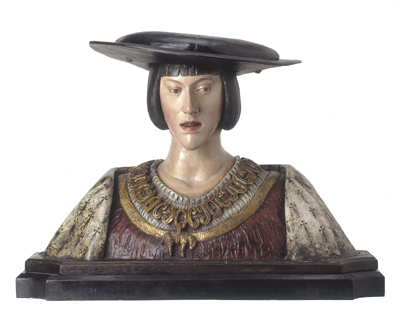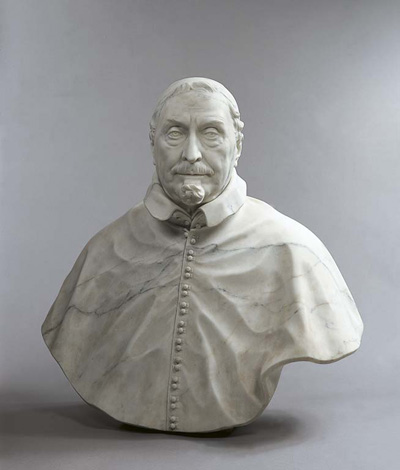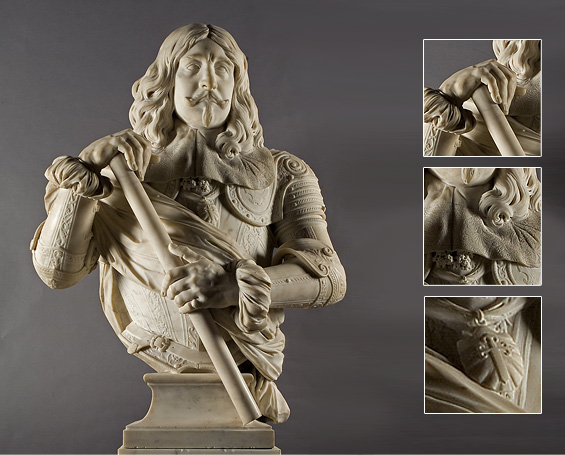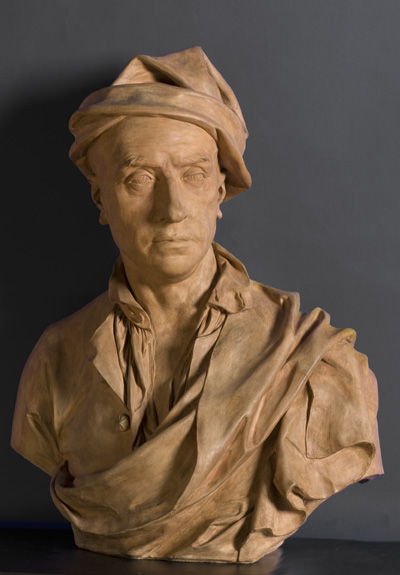Portrait Sculpture in the Lower Countries 1600-1800
Until the Renaissance, sculptured portraits were mainly religious. Saints were represented with impersonal, idealised features. Their sculptured busts were often part of a reliquary. They were meant to represent a saint’s presence in mortal remains, preserved in the reliquary, in a way that was more visible for the believers. With the ‘revival’ of classical art in the 16th century, this started to change. Artists gradually paid more attention to the unique individuality of their faces. It was the first step to a flourishing of secular portraiture in the New Times. Authorities, savants and artists immortalised their names in wood, clay or stone sculptures. They had themselves represented as classical emperors, philosophers, writers or other personalities whose moral or intellectual qualities they emulated.
The six busts that we will study here, illustrate the style evolution in portrait sculpture in the Lower Countries from the 16th to the 18th century, from the first shy attempts to copy the Antique style premises to Baroque grandeur, mannered exuberance and finally disarming naturalism. What makes these sculptures so attractive is their incredible lifelikeness and their theatrical mise-en-scène.
Bust of Charles V (ca. 1520)
Only the neck and the head, made in clay, and the removable wooden hat are original parts from the 16th century. The painted bust with the coat and the Golden Fleece chain were added in 1882.

Research in archives has shown that Charles V was depicted several times in natural stone, baked pipe clay or terracotta. The prototype for this bust was probably made by the sculptor, Conrad Meit, who worked at the court of Margaret of Austria.
Although the bottom of the bust is cut straight, a traditional feature, we can now notice several new elements, e.g. the direction of his eyes gives movement to the composition, and the king’s very recognisable features are well represented – his typical narrow head, sharp chin, half-open mouth with fleshy lips, and his heavy nose. This striving for more realism reveals the artists’ knowledge of classical art.
Portrait of Antonius Triest, Bishop of Ghent (ca. 1643-1651?)
This portrait of the Ghent Bishop Antonius Triest not only owes its exceptional importance to the its technical quality – thanks to the sculptor’s talent – but also to the use of white marble, an exclusive material that, in the Southern Netherlands, was usually reserved for portraits of governors and nobles.

The portrait of Bishop Antonius Triest was possibly made for his tombstone in the Ghent cathedral, illustrating one of the portrait’s primary functions: to provide a visual means to remember the dead. Therefore, they are often used on epitaphs and gravestones. In the New Times, these memorials occupied an important place inside the church. With this form of patronage – an alternative to the usual forms of charity – the commissioners hoped to contribute to their salvation in the hereafter.
AIt is possible that both Duquesnoy brothers worked on this distinguished and delicate portrait of Antonius Triest. François Duquesnoy, the most famous sculptor from the Southern Netherlands in the 17th century, spent an important part of his life in Italy, where he was known as Il Fiammingo. He developed a classicising Baroque style, different from the theatrical Baroque of Gianlorenzo Bernini (1598-1680). The fact that Antonius Triest first used François to have his portrait for his tombstone at the Ghent cathedral, shows the delicate taste of this art lover and patron. However, the work is signed by his brother Jérôme, who supposedly finished it after François’ death. Jérôme also made the tombstone for Bishop Triest (1651-1654).
The Triest portrait is a clear example of the Duquesnoy brothers’ talent, especially for the way they show the folds of the clothes and the extreme sense of detail in the elaboration of the physiognomy. The use of the bottom of the mozzetta or tippet as the contour line of the bust is very typical. This is not an exclusive motive in François Duquesnoy’s work, but a common feature in contemporary Italian portrait art in general. It is also used in the portraits of François’ Roman equal Bernini (e.g. in the portrait of Urbanus VIII, 1632, Rome, Palazzo Barberini). The striking cut under the mozzetta, which suggests the presence of the (invisible) bended left arm, illustrates the Duquesnoys’ striving for realism and even illusionism.
Portrait of Cornelis II Landschot (ca. 1656)
The bust of Cornelis Landschot used to adorn the chapel of the charity institution that he founded in his memory. Cornelis II Landschot was a devout, wealthy Antwerp businessman. He gave the order to build a place of worship on the Falconrui after he died. The bust of the generous patron was placed on top of the chapel’s entrance, on the inside. Beneath the bust were the words: “Pray for the donor”.

According to Jacob Van der Sanden, the 18th century historiographer of the Antwerp art scene, this impressive portrait of Cornelis II Landschot (1570-1656) was made by Sebastiaan van den Eynde. The bust illustrates the strong influence of contemporary Italian sculpture (where the Brussels-born François Duquesnoy played a trend-setting role) on portrait art in the Lower Countries.
Cornelis Landschot is represented in a modest shirt with a square collar. A fine cloth is draped on top of it, fixed with a round pin on the left shoulder, and totally covering the bottom of the bust. The composition gives the impression that the cape has been draped around the shoulder. Both the cape and the pin remind of the Antique examples from the Italian cinquecento, inspired by Roman portrait art, e.g. the portrait of Brutus by Michelangelo (1539-40; Florence, Museo Nazionale del Bargello). Van den Eynde had studied the work of his Italian predecessors with his own eyes during a study trip right before he made this work. The technical quality of this sculpture is in no way inferior to that of its Italian examples. The commissioner was portrayed accurately by the extremely fine surfacing of the physiognomy. The artist depicted him slightly bending forward, so that the worshipers could better see the benefactor from a frog’s perspective when they left the chapel.
Portrait of Luis Francisco de Benavides (1664)
This magnificent sculpture by Artus I Quellinus is undoubtedly one of the most important pieces of the sculpture collection at the Royal Museum of Fine Arts Antwerp. The artist made this work in a later phase of his career, when his style started to feature a typical Baroque grandeur.
Quellinus the Older occupies a central place in sculpture in the 17th century Lower Countries. He is mainly known for his works at the former Amsterdam City Hall (now the Palace on the Dam), which he richly decorated with sculptures. He was also a successful portrait maker. His busts are famous for their monumental design, their psychologically correct naturalism and the special attention to the representation of the hands. His portraits of Amsterdam mayors set the tone for a totally new character genre: the ‘middle-class authority portrait’.

Governor of the Spanish Netherlands, 1664,
Royal Museum of Fine Arts Antwerp, inv. 701
Portrait of Maximilian II Emmanuel (1694)
Just like Quellinus’ portrait of Luis Francisco de Benavides, this impressive, sophisticated portrait bust by Willem Kerrickx comes from the premises of the former Antwerp St. Lucas Guild. It represents Maximilian II Emmanuel, the Elector of Bavaria and Governor of the Spanish Netherlands (1691-1706). The Antwerp St. Lucas Guild had this portrait made in gratitude for the governor’s financial support to the academy. Thanks to him, it was possible to take drawing classes ‘based on the classical plastering art’.

Netherlands, 1694, Royal Museum of Fine Arts Antwerp, inv. 678
Just like de Benavides, the governor is depicted up to his waist and with his military equipment. However, there is an important style difference: here, we could say it is overdone and stylised. Kerrickx emphasises the dignity of the governor’s position by the solemn pose, with the right hand resting on his hip. The marshal’s staff is resting casually on his left arm. The breastplate of his armour suit is adorned with miniature portraits, probably of emperors from Classical Antiquity, and other personages that the governor admired. Over the armour suit, he is wearing an ermine edged cape. Both the breast strip and the sleeves are generously adorned with lace. Around his neck, he is wearing a chain with the symbol of the Order of the Golden Fleece. The draping of the jabot and the cape, and the wind that seems to play with the hairs of the long allonge peruke, give the composition a dynamic look. The idealised and abstracted physiognomy of the face and the mannered excess of details in the hair and the clothes, are in sharp contrast with the realism of both other busts. These style features announced the new tastes seen in the first half of the 18th century.
For this portrait, Willem Kerricx received 800 guilders, a very important sum in that time. It is one of the best works ever in the oeuvre of this artist, who created magnificent, ornamented furniture for countless churches. Like Lodewijk Willemsens, who made the third sculptured portrait from the Gallery of Honour at the St. Lucas Guild, Kerrickx often worked together with the studio of Quellinus and Verbruggen. Both families became related when Artus I Quellinus’s sister, Cornelia, married Peter I Verbruggen, another protagonist in the sculpture of the 17th century Southern Netherlands.
Self-portrait of John Michael Rysbrack (ca. 1730)
The striking thing about this work is the fine terracotta workmanship, making it an autonomous work of art, rather than a moulded model for a marble bust. This expressive portrait is most probably a self-portrait. The model was identified thanks to the portrait of Rysbrack by the English painter John Vanderbank at the London National Portrait Gallery. It illustrates the style change in portrait sculpture in the 18th century. From then on, a disarming naturalism would set the tone.

Rysbrack was from Antwerp. He probably received his training at Michiel van der Voort’s studio. In 1720, he moved to England, where he made a successful career. He was especially known for his tombstones. This portrait belongs to the 18th century iconographical tradition of the sculptor’s and the architect’s portraits, that depict the artists very informally, and usually wearing a draped cape that reminds of the Antique portrait. By doing so, the person who is represented strives for the same fame as his illustrious precursors from Antiquity.
Rysbrack’s self-portrait belongs to the former Charles Van Herck collection, which the King Baldwin Foundation bought in 1996. The Foundation has given the work on loan to the Royal Museum of Fine Arts Antwerp.
